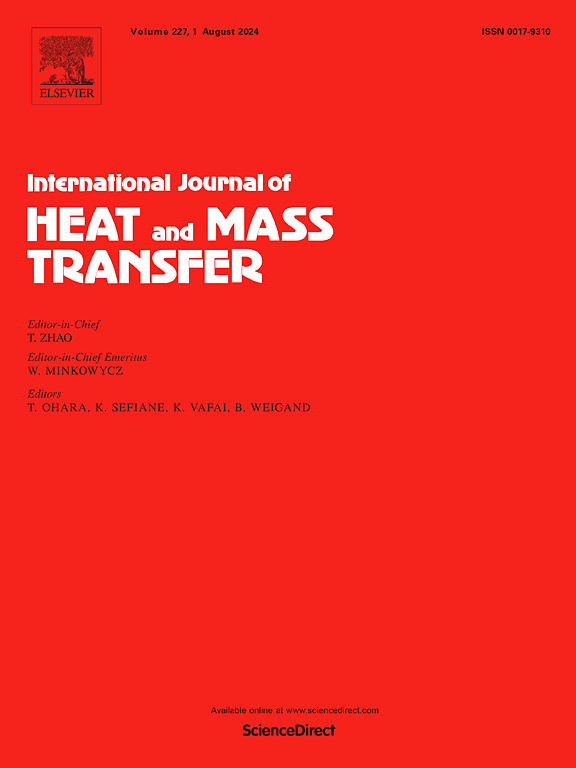生物炭基复合相变材料热性能和形态稳定性的分子动力学模拟
IF 5.8
2区 工程技术
Q1 ENGINEERING, MECHANICAL
International Journal of Heat and Mass Transfer
Pub Date : 2025-06-04
DOI:10.1016/j.ijheatmasstransfer.2025.127354
引用次数: 0
摘要
生物炭基复合相变材料是一种新型的复合材料,由于其优异的形状稳定性和增强的导热性,在相变储能技术中具有重要的潜力。为了研究生物炭对相变材料热性能的影响及其微观机制,建立了硬脂酸/玉米秸秆生物炭复合相变材料的分子模型。通过分子动力学模拟,分析了温度和生物炭质量分数对复合相变材料导热系数、比热容、态振动密度、内能组成、平均取向位移和自扩散系数的影响。结果表明,生物炭的掺入显著提高了硬脂酸的比热容和导热系数,且导热系数与生物炭质量分数呈正相关。与石墨烯碳纳米材料不同,玉米秸秆生物炭的声子传热主要受20-50太赫兹频率范围内声子振动的影响,与SA表现出有效的声子耦合,从而提高了传热效率。玉米秸秆生物炭的加入提高了复合体系的组装键能和静态能,降低了扩散系数和分子距离,加强了分子间的连接,促进了相变过程中的形状稳定性。玉米秸秆生物炭中的特定官能团可以与硬脂酸形成氢键,进一步提高复合相变材料的导热性和整体稳定性。本文章由计算机程序翻译,如有差异,请以英文原文为准。

Molecular dynamics simulation of thermal properties and morphological stability of biochar-based composite phase change materials
Biochar-based composite phase change materials represent a novel class of composites with significant potential in phase-change energy storage technology, attributed to their excellent shape stability and enhanced thermal conductivity. To investigate the influence of biochar on the thermal properties of phase change materials and the underlying microscopic mechanisms, a molecular model of stearic acid /corn stalk biochar composite phase change materials was developed. Through molecular dynamics simulations, we analyzed the effects of temperature and biochar mass fraction on thermal conductivity, specific heat capacity, vibration density of states, internal energy composition, mean orientation shift, and self-diffusion coefficient of composite phase change materials. The results demonstrated that the incorporation of biochar significantly increased the specific heat capacity and thermal conductivity of stearic acid, with thermal conductivity positively correlated with the biochar mass fraction. Unlike graphene carbon nanomaterials, corn stalk biochar's phonon heat transfer is predominantly influenced by phonon vibrations in the 20–50 THz frequency range, exhibiting effective phonon coupling with SA, thereby enhancing heat transfer efficiency. The addition of corn stalk biochar increases the assembly bond energy and static energy of the composite system, reduces the diffusion coefficient and molecular distance, strengthening intermolecular connections and promoting shape stability during phase transitions. Specific functional groups within corn stalk biochar can form hydrogen bonds with stearic acid, further enhancing the thermal conductivity and overall stability of composite phase change materials.
求助全文
通过发布文献求助,成功后即可免费获取论文全文。
去求助
来源期刊
CiteScore
10.30
自引率
13.50%
发文量
1319
审稿时长
41 days
期刊介绍:
International Journal of Heat and Mass Transfer is the vehicle for the exchange of basic ideas in heat and mass transfer between research workers and engineers throughout the world. It focuses on both analytical and experimental research, with an emphasis on contributions which increase the basic understanding of transfer processes and their application to engineering problems.
Topics include:
-New methods of measuring and/or correlating transport-property data
-Energy engineering
-Environmental applications of heat and/or mass transfer

 求助内容:
求助内容: 应助结果提醒方式:
应助结果提醒方式:


